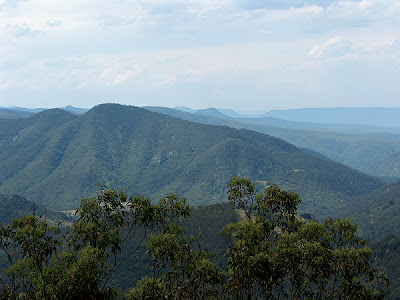On the way back from Bullio I stopped at the Wollondilly Look Out. This is the very southern tip of the Southern Blue Mountains. It is part of the "Nattai Wilderness", itself part of the "Greater Blue Mountains World Heritage Area"
 As that website describes this region, "The area does not contain mountains in the conventional sense but is described as a deeply incised sandstone plateau rising from less than 100 metres above sea level to 1 300 metres at the highest point. There are basalt outcrops on the higher ridges." You can clearly see the sandstone strata of the entire plateau. What is less apparent is that the very far distant (blue) horizon is the far side of the same plateau (the "Lower Blue Mountains". The bit in the middle has been eroded over millions of years, by the Wollondilly, Nattai, Jamison and Cox's Rivers. If those river names are not familiar, they ought be, for they are the main rivers supplying Lake Burrogorang (the Warragamba Dam), which is out of sight from this position, around the corner past Bonum Pic, and about 30 Km away. It is shown on the map.
As that website describes this region, "The area does not contain mountains in the conventional sense but is described as a deeply incised sandstone plateau rising from less than 100 metres above sea level to 1 300 metres at the highest point. There are basalt outcrops on the higher ridges." You can clearly see the sandstone strata of the entire plateau. What is less apparent is that the very far distant (blue) horizon is the far side of the same plateau (the "Lower Blue Mountains". The bit in the middle has been eroded over millions of years, by the Wollondilly, Nattai, Jamison and Cox's Rivers. If those river names are not familiar, they ought be, for they are the main rivers supplying Lake Burrogorang (the Warragamba Dam), which is out of sight from this position, around the corner past Bonum Pic, and about 30 Km away. It is shown on the map. One can see virtually all the way to Katoomba from here.
One can see virtually all the way to Katoomba from here. The sandstone cliff peak at the centre of the image below, is known as "Bonum Pic". It is slightly lower than Mt Wanganderry, (out of sight to the right) a basalt cap just east from Bonum Pic.
The sandstone cliff peak at the centre of the image below, is known as "Bonum Pic". It is slightly lower than Mt Wanganderry, (out of sight to the right) a basalt cap just east from Bonum Pic. The intergrade between the basalt and the sandstone is very marked in this district. This view is of classic sandstone plateaux and valleys, but it is only a few kilometres from Bullio, which is Granite country (as seen in the photos I published a few days ago). The Wollondilly valley has very complex geology. It also has some very determined settlers, if you click on the image above, you will see what I mean. Look for a rough track and houses amongst the trees, way down in the bottom of the valley.
The intergrade between the basalt and the sandstone is very marked in this district. This view is of classic sandstone plateaux and valleys, but it is only a few kilometres from Bullio, which is Granite country (as seen in the photos I published a few days ago). The Wollondilly valley has very complex geology. It also has some very determined settlers, if you click on the image above, you will see what I mean. Look for a rough track and houses amongst the trees, way down in the bottom of the valley.Here is a gentler side to these wonderful mountains: Just past the Wollondilly Lookout, one goes through a "tunnel" - actually a hole cut through a very narrow sandstone ridge. As soon as you go through the tunnel, from east, heading west, you come into a patch of sheltered moist forest (protected from the heat of the northerly sun). There were many of these Blueberry Ash trees in full flower (Elaeocarpus reticulatus)


No comments:
Post a Comment